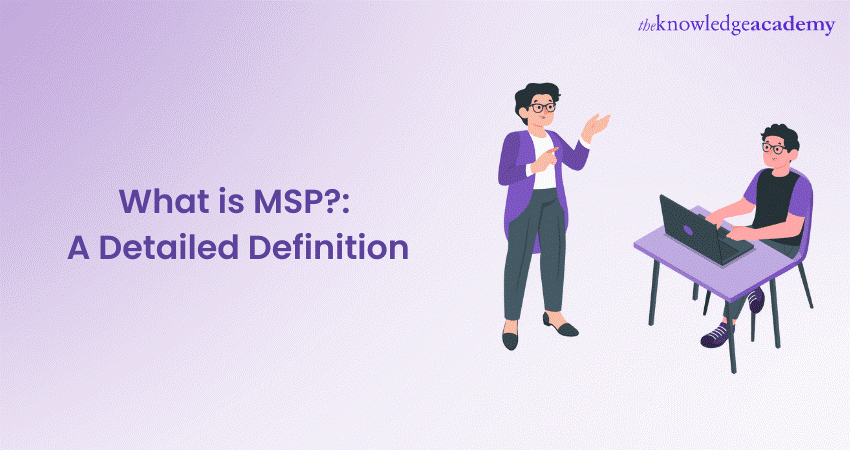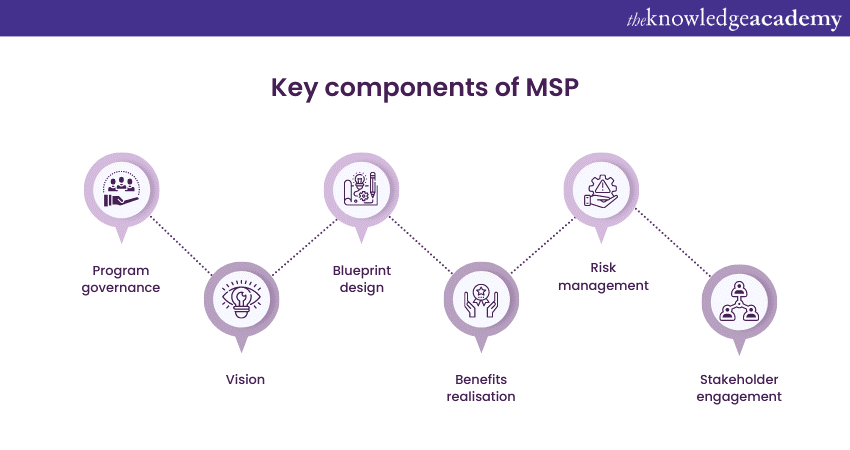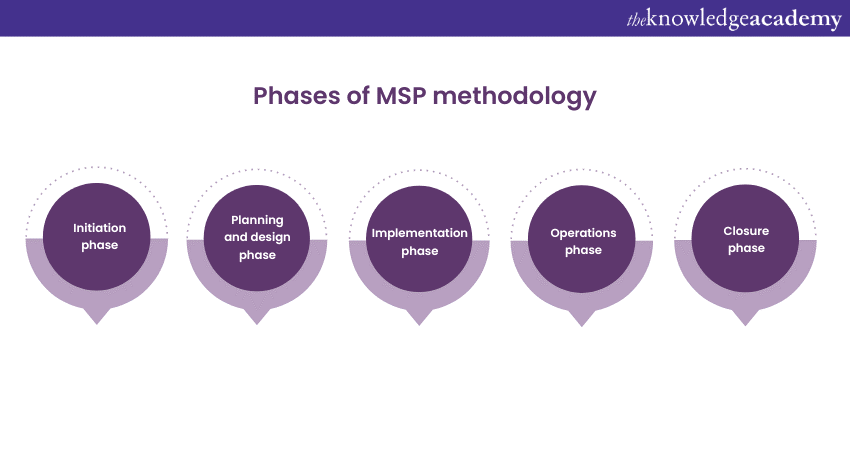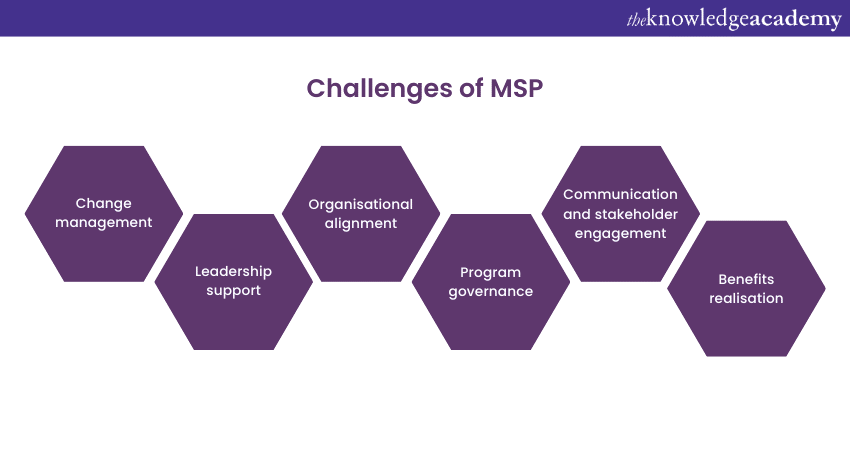We may not have the course you’re looking for. If you enquire or give us a call on 01344203999 and speak to our training experts, we may still be able to help with your training requirements.
Training Outcomes Within Your Budget!
We ensure quality, budget-alignment, and timely delivery by our expert instructors.

In today’s dynamic business landscape, organisations are finding it difficult to manage multiple programs or initiatives together and ensure their success. This is where Managing Successful Programmes (MSP) comes into play. Professionals from various industries have been intrigued by the idea of a framework that can help manage programmes efficiently, and since then the question ‘What is MSP?’ has become prevalent.
MSP is a powerful framework that enables organisations to manage complex and interconnected projects within a program. It emphasises the importance of aligning projects with strategic objectives to deliver successful outcomes and maximise benefits.
This blog will aid in answering questions like What is MSP, explore its benefits, methodology, and more.
Table of Contents
1) An introduction to MSP
2) MSP methodology
3) MSP vs Project management
4) Challenges in implementing MSP
5) Conclusion
An introduction to MSP
Managing Successful Programme or MSP is a comprehensive approach that helps organisations effectively manage difficult projects in a program. It provides a structured framework that aligns projects with strategic goals and ensures the realisation of desired outcomes. To fully grasp the concept of MSO, it is essential to be aware of its key elements and benefits. Let’s look at these aspects of MSP in detail:
Key components
At the heart of MSP lies the recognition that programs consist of interconnected projects that collectively contribute to achieving strategic goals. The key elements of MSP include:

1) Program governance: MSP emphasises the need for effective program governance structures that define roles, responsibilities, and decision-making processes. This ensures the program remains on track, aligned with strategic objectives, and delivers the intended benefits.
2) Vision: A clear program vision statement is essential in MSP. It sets out the program's desired outcomes, benefits, and strategic alignment. The vision is a guiding principle, providing a shared understanding and direction for all stakeholders.
3) Blueprint design: MSP involves developing a blueprint or roadmap that outlines the program's activities, projects, and dependencies. This blueprint serves as a comprehensive plan, guiding the program's implementation and ensuring that all projects work together towards achieving the desired outcomes.
4) Benefits realisation: MSP places significant emphasis on benefits realisation. It involves identifying, tracking, and measuring the expected benefits of the program. By actively managing benefits throughout the program's lifecycle, organisations can ensure that the desired value is achieved.
5) Risk management: Effective risk management is vital in MSP. Programs often face uncertainties and potential challenges that can hinder success. MSP incorporates risk management processes to identify, assess, and mitigate risks, ensuring they are proactively managed to minimise their impact on the program's objectives.
6) Stakeholder engagement: Engaging stakeholders is crucial in MSP. It involves identifying and involving individuals or groups affected by the program. MSP emphasises the need for effective communication, collaboration, and managing stakeholder expectations to gain their support and ensure program success.
Benefits of MSP
There are several benefits of adopting MSP for organisations, and they are as follows:
1) Strategic alignment: MSP aligns projects within a program with strategic objectives, ensuring that resources and efforts are focused on activities that contribute to organisational goals.
2) Improved program governance: MSP provides a structured governance framework, ensuring clear roles, responsibilities, and decision-making processes, enabling effective oversight and control over the program.
3) Enhanced risk management: MSP incorporates robust risk management practices, allowing organisations to identify and address potential risks and uncertainties, minimising their impact on program success.
4) Increased stakeholder satisfaction: By actively engaging stakeholders throughout the program, MSP promotes collaboration, transparency, and effective communication, resulting in greater stakeholder satisfaction and support.
5) Optimised resource utilisation: MSP facilitates efficient resource allocation and utilisation across projects within a program, ensuring that resources are utilised effectively to achieve desired outcomes.
Become proficient in programme management with our MSP® Foundation Course now!
MSP methodology
The MSP methodology provides a structured approach to managing successful programs, guiding organisations through the various phases of program management. Let's explore the key phases of the MSP methodology and understand their significance in ensuring program success:

1) Initiation phase
The initiation phase sets the foundation for the program. The program is defined during this phase, and the necessary governance and leadership structures are established. The program's vision is developed, outlining the desired outcomes and benefits. A blueprint is created to guide the program's activities, highlighting the key projects and their interdependencies.
2) Planning and design phase
In this phase, detailed planning takes place. Project plans are developed, including the scope, schedule, resources, and budgets. Project controls and reporting mechanisms are established to monitor progress and ensure the program's objectives are aligned. Risks and dependencies are identified, and appropriate mitigation strategies are implemented. The program blueprint is further refined, incorporating detailed project plans.
3) Implementation phase
The implementation phase begins with the execution of the program's projects according to the plans developed in the previous phase. Project teams are mobilised, and activities are initiated. Progress is closely monitored, and regular communication is maintained to keep stakeholders informed. Any necessary adjustments or corrective actions are taken to ensure the program's success.
4) Operations phase
Once the program is implemented, it enters the operations phase. During this phase, the focus shifts from project execution to program management and benefits realisation. The program is managed, and ongoing monitoring and control are conducted to track progress and ensure the intended benefits are achieved. Risks are actively managed, and corrective actions are taken as needed.
5) Closure phase
The closure phase marks the end of the program. A post-implementation review assesses the program's overall performance and identifies lessons learned. Any remaining activities or outstanding issues are addressed, and the program's outputs and benefits transition to business-as-usual operations. A formal program closure report is prepared, documenting the achievements, challenges, and recommendations for future programs.
MSP vs Project management
While both MSP and project management play crucial roles in achieving organisational objectives, they have distinct focuses and scopes. Let's explore the differences between MSP and project management:
|
Aspect |
MSP |
Project management |
|
Focus |
Strategic alignment, program management |
Execution and control of individual projects |
|
Scope |
Manages programs consisting of interrelated projects |
Manages individual projects with specific objectives |
|
Strategic objectives |
Aligned with overall organisational goals and outcomes |
Achieving project-specific deliverables within defined constraints |
|
Benefits |
Strong emphasis on benefits realisation |
Focuses on delivering project outputs and achieving project objectives |
|
Governance and leadership |
Establishes program governance and leadership structures |
Project governance and project manager provide leadership |
|
Timeframe |
Long-term perspective, focuses on achieving lasting change |
Temporary in nature, with defined start and end dates |
|
Resource allocation |
Optimises resource allocation across projects within a program |
Allocates resources specific to individual projects |
|
Coordination |
Manages interdependencies between projects within a program |
Focuses on coordination within the project |
|
Reporting and communication |
Establishes program-level reporting and communication mechanisms |
Focuses on project-specific reporting and communication |
|
Scope management |
Ensures program scope aligns with strategic objectives and evolves |
Manages and controls project scope, handles changes |
|
Team management |
Emphasises program-level team management and stakeholder engagement |
Manages project team, assigns tasks, and ensures project completion |
Complementary roles
MSP and project management work hand in hand to deliver successful outcomes. While MSP provides the overarching governance and strategic alignment, project management ensures effective execution at the project level. Here's how they complement each other:
1) Clear alignment: MSP aligns projects within a program with strategic objectives, providing a framework for project managers to ensure their work contributes to the program's goals.
2) Governance integration: Project managers operate within the governance structure defined by MSP, following its principles and guidelines to manage their projects effectively.
3) Coordination and integration: MSP provides coordination and integration mechanisms to manage interdependencies between projects, ensuring they work together seamlessly towards program objectives.
4) Resource optimisation: MSP optimises resource allocation across projects within a program, while project managers focus on resource allocation specific to their projects.
5) Reporting and communication: MSP establishes reporting and communication mechanisms to keep stakeholders informed about program progress while project managers communicate project-specific updates.
Enhance your programme management skills by signing up for our MSP® Practitioner Course today!
Challenges in implementing MSP
Implementing MSP can present various challenges organisations must address to ensure a successful program management journey. Let's explore some common challenges and considerations when implementing MSP:

1) Change management: One of the significant challenges in implementing MSP is managing organisational change. MSP often involves driving transformational change, which can face resistance from employees accustomed to existing processes and practices. Effective change management strategies, including communication, training, and stakeholder engagement, are crucial to overcome resistance and foster a positive adoption of MSP.
2) Leadership support: Gaining leadership support is essential for successful MSP implementation. Leaders must understand the benefits of MSP, provide resources, and actively participate in the program. Without strong leadership support, there may be difficulties in securing the necessary funding, decision-making, and establishing a culture that embraces the MSP approach.
3) Organisational alignment: MSP requires alignment across different organisational levels and functions. Program goals and objectives should align with the overall strategic direction, and stakeholders from various departments must collaborate and work together towards common outcomes. Lack of alignment can lead to conflicting priorities and resource allocation challenges and hinder the successful implementation of MSP.
4) Program governance: Establishing an effective program governance structure is crucial but challenging. Clear roles, responsibilities, and decision-making processes must be defined and communicated. Program governance should provide oversight, control, and escalation mechanisms to ensure program success. A lack of robust governance can lead to confusion, delays, and ineffective decision-making.
5) Communication and stakeholder engagement: Effective communication and stakeholder engagement are vital in MSP. Engaging and aligning stakeholders with the program's objectives, progress, and benefits is crucial for success. Communication challenges can arise from diverse stakeholder groups, differing interests, and the need to maintain transparency and open communication channels throughout the program lifecycle.
6) Benefits realisation: Tracking and measuring the benefits and outcomes of the program can be challenging. Defining meaningful metrics, establishing baselines, and monitoring progress towards achieving program benefits require careful planning and ongoing measurement. Organisations must have appropriate systems and processes to track benefits realisation effectively.
Conclusion
Implementing MSP provides organisations with a structured and strategic approach to program management, enabling them to achieve their desired outcomes and benefits. We hope this blog has helped answer questions like ‘What is MSP?’ and enhance your understanding of its benefits, methodology, challenges, and more.
Elevate your skills and propel your career forward by registering for our MSP® Foundation & Practitioner Course today!
Frequently Asked Questions
Upcoming Project Management Resources Batches & Dates
Date
 MSP® Foundation & Practitioner
MSP® Foundation & Practitioner
Sat 18th May 2024, Sun 19th May 2024
Mon 20th May 2024
Tue 28th May 2024
Mon 3rd Jun 2024
Mon 10th Jun 2024
Sat 15th Jun 2024, Sun 16th Jun 2024
Mon 17th Jun 2024
Mon 24th Jun 2024
Mon 1st Jul 2024
Mon 8th Jul 2024
Sat 13th Jul 2024, Sun 14th Jul 2024
Mon 15th Jul 2024
Mon 22nd Jul 2024
Mon 29th Jul 2024
Mon 5th Aug 2024
Sat 10th Aug 2024, Sun 11th Aug 2024
Mon 12th Aug 2024
Mon 19th Aug 2024
Tue 27th Aug 2024
Mon 2nd Sep 2024
Mon 9th Sep 2024
Sat 14th Sep 2024, Sun 15th Sep 2024
Mon 16th Sep 2024
Mon 23rd Sep 2024
Mon 30th Sep 2024
Mon 7th Oct 2024
Mon 14th Oct 2024
Sat 19th Oct 2024, Sun 20th Oct 2024
Mon 21st Oct 2024
Mon 28th Oct 2024
Mon 4th Nov 2024
Mon 11th Nov 2024
Sat 16th Nov 2024, Sun 17th Nov 2024
Mon 18th Nov 2024
Mon 25th Nov 2024
Mon 2nd Dec 2024
Mon 9th Dec 2024
Sat 14th Dec 2024, Sun 15th Dec 2024
Mon 16th Dec 2024
Mon 6th Jan 2025
Mon 13th Jan 2025
Mon 20th Jan 2025
Mon 27th Jan 2025
Mon 3rd Feb 2025
Mon 10th Feb 2025
Mon 17th Feb 2025
Mon 24th Feb 2025
Mon 3rd Mar 2025
Mon 10th Mar 2025
Mon 17th Mar 2025
Mon 24th Mar 2025
Mon 31st Mar 2025
Mon 7th Apr 2025
Mon 14th Apr 2025
Tue 22nd Apr 2025
Mon 28th Apr 2025
Tue 6th May 2025
Mon 12th May 2025
Mon 19th May 2025
Tue 27th May 2025
Mon 2nd Jun 2025
Mon 9th Jun 2025
Mon 16th Jun 2025
Mon 23rd Jun 2025
Mon 30th Jun 2025
Mon 7th Jul 2025
Mon 14th Jul 2025
Mon 21st Jul 2025
Mon 28th Jul 2025
Mon 4th Aug 2025
Mon 11th Aug 2025
Mon 18th Aug 2025
Tue 26th Aug 2025
Mon 1st Sep 2025
Mon 8th Sep 2025
Mon 15th Sep 2025
Mon 22nd Sep 2025
Mon 29th Sep 2025
Mon 6th Oct 2025
Mon 13th Oct 2025
Mon 20th Oct 2025
Mon 27th Oct 2025
Mon 3rd Nov 2025
Mon 10th Nov 2025
Mon 17th Nov 2025
Mon 24th Nov 2025
Mon 1st Dec 2025
Mon 8th Dec 2025
Mon 15th Dec 2025







 Top Rated Course
Top Rated Course



 If you wish to make any changes to your course, please
If you wish to make any changes to your course, please


